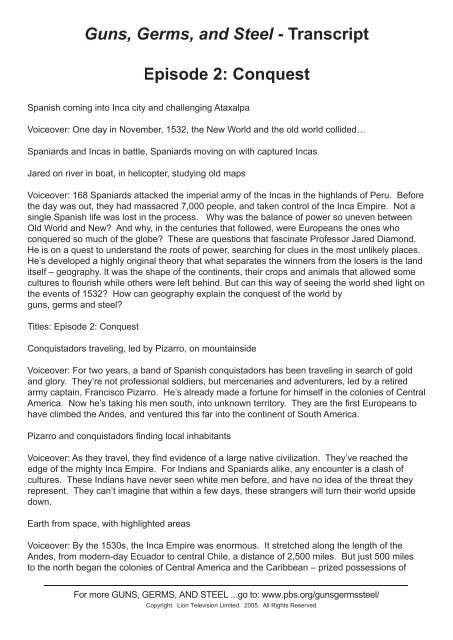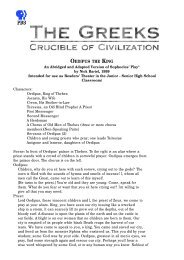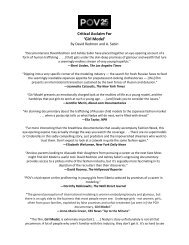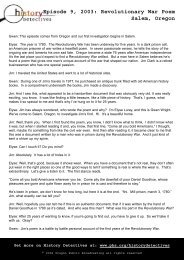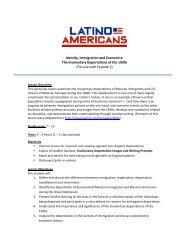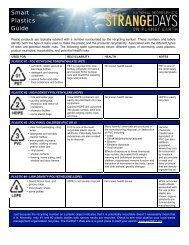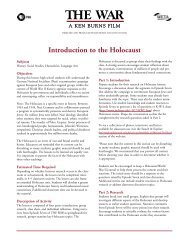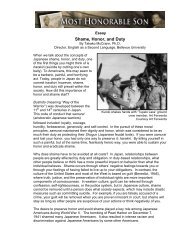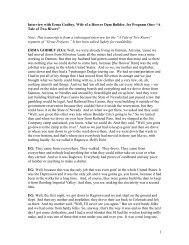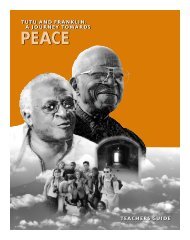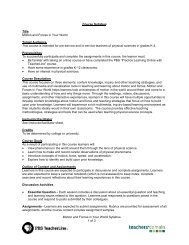Guns, Germs, and Steel - Transcript Episode 2: Conquest - PBS
Guns, Germs, and Steel - Transcript Episode 2: Conquest - PBS
Guns, Germs, and Steel - Transcript Episode 2: Conquest - PBS
- No tags were found...
You also want an ePaper? Increase the reach of your titles
YUMPU automatically turns print PDFs into web optimized ePapers that Google loves.
<strong>Guns</strong>, <strong>Germs</strong>, <strong>and</strong> <strong>Steel</strong> - <strong>Transcript</strong><strong>Episode</strong> 2: <strong>Conquest</strong>Spanish coming into Inca city <strong>and</strong> challenging AtaxalpaVoiceover: One day in November, 1532, the New World <strong>and</strong> the old world collided…Spaniards <strong>and</strong> Incas in battle, Spaniards moving on with captured IncasJared on river in boat, in helicopter, studying old mapsVoiceover: 168 Spaniards attacked the imperial army of the Incas in the highl<strong>and</strong>s of Peru. Beforethe day was out, they had massacred 7,000 people, <strong>and</strong> taken control of the Inca Empire. Not asingle Spanish life was lost in the process. Why was the balance of power so uneven betweenOld World <strong>and</strong> New? And why, in the centuries that followed, were Europeans the ones whoconquered so much of the globe? These are questions that fascinate Professor Jared Diamond.He is on a quest to underst<strong>and</strong> the roots of power, searching for clues in the most unlikely places.He’s developed a highly original theory that what separates the winners from the losers is the l<strong>and</strong>itself – geography. It was the shape of the continents, their crops <strong>and</strong> animals that allowed somecultures to fl ourish while others were left behind. But can this way of seeing the world shed light onthe events of 1532? How can geography explain the conquest of the world byguns, germs <strong>and</strong> steel?Titles: <strong>Episode</strong> 2: <strong>Conquest</strong>Conquistadors traveling, led by Pizarro, on mountainsideVoiceover: For two years, a b<strong>and</strong> of Spanish conquistadors has been traveling in search of gold<strong>and</strong> glory. They’re not professional soldiers, but mercenaries <strong>and</strong> adventurers, led by a retiredarmy captain, Francisco Pizarro. He’s already made a fortune for himself in the colonies of CentralAmerica. Now he’s taking his men south, into unknown territory. They are the fi rst Europeans tohave climbed the Andes, <strong>and</strong> ventured this far into the continent of South America.Pizarro <strong>and</strong> conquistadors fi nding local inhabitantsVoiceover: As they travel, they fi nd evidence of a large native civilization. They’ve reached theedge of the mighty Inca Empire. For Indians <strong>and</strong> Spaniards alike, any encounter is a clash ofcultures. These Indians have never seen white men before, <strong>and</strong> have no idea of the threat theyrepresent. They can’t imagine that within a few days, these strangers will turn their world upsidedown.Earth from space, with highlighted areasVoiceover: By the 1530s, the Inca Empire was enormous. It stretched along the length of theAndes, from modern-day Ecuador to central Chile, a distance of 2,500 miles. But just 500 milesto the north began the colonies of Central America <strong>and</strong> the Caribbean – prized possessions ofFor more GUNS, GERMS, AND STEEL ...go to: www.pbs.org/gunsgermssteel/Copyright. Lion Television Limited. 2005. All Rights Reserved.
the Spanish empire. At the time, the Spanish king controlled a third of mainl<strong>and</strong> Europe, butSpain itself had only recently become a unifi ed state, having fought off 700 years of occupation byIslamic Moors.Pizarro’s home, with Jared walking around itVoiceover: It was still a rural society. Most of the conquistadors came from villages <strong>and</strong> smalltowns in the heart of the country; towns like Trujillo, where Pizarro grew up. He spent much of hischildhood here, working as a swineherd in the fi elds nearby. Today he’s remembered as a greatwarrior. His statue dominates the main square in Trujillo, <strong>and</strong> his family home has been turnedinto a museum. Jared Diamond has come here to explore the world of the conquistadors, <strong>and</strong>underst<strong>and</strong> the secret of their success.Statue of PizarroJared Diamond: This is Francisco Pizarro, a Spaniard who conquered the most powerful state inthe New World, the Inca Empire. Why did Pizarro <strong>and</strong> his men conquer the Incas instead of theother way round? It seems like a simple question. The answer isn’t immediately obvious. Afterall, Pizarro started out as a rather ordinary person, <strong>and</strong> Trujillo here is a rather ordinary town. Sowhat is it that gave Pizarro <strong>and</strong> his men this enormous power?Pizarro <strong>and</strong> conquistadors travelingJared Diamond: Why am I so interested in Pizarro’s conquistadors? Because their story is such agrimly successful example of European conquest. And for 30 years I’ve been exploring patterns ofconquest.Voiceover: Jared Diamond is a professor at UCLA in Los Angeles. But most of his fi eldwork hasbeen done in Papua New Guinea. His time there inspired him to explore the roots of inequalityin the modern world. To underst<strong>and</strong> why some people have been able to dominate <strong>and</strong> conquerothers. Looking back thous<strong>and</strong>s of years, he argues that farming gave some cultures anenormous head start, <strong>and</strong> those who were lucky enough to have the most productive crops <strong>and</strong>animals became the most productive farmers. Agriculture fi rst developed in a part of the MiddleEast known as the Fertile Crescent. Over time, crops <strong>and</strong> animals from the Fertile Crescentspread into North Africa <strong>and</strong> Europe, where they triggered an explosion of civilization. By the 16thCentury, European farms were dominated by livestock animals that had come from the FertileCrescent. None were native to Europe. They provided more than just meat. They were a sourceof milk <strong>and</strong> wool, leather <strong>and</strong> manure. And crucially, they provided muscle power.Mules pulling ploughs, Incas cultivating l<strong>and</strong> as llamas look on, Conquistadors riding onto Incal<strong>and</strong>Voiceover: Harnessed to a plough, a horse or an ox could transform the productivity of farml<strong>and</strong>.European farmers were able to grow more food to feed more people, who could then build bigger<strong>and</strong> more complex societies. In the New World, there were no horses or cattle for farming. Allthe work had to be done by h<strong>and</strong>. The only large domestic animal was the llama, but thesedocile creatures have never been harnessed to a plough. The Incas were very skilled at growingpotatoes <strong>and</strong> corn, but because of their geography, they could never be as productive asEuropean farmers. Horses gave Europeans another massive advantage – they could be ridden.To the Incas, the sight of Pizarro’s conquistadors passing through their l<strong>and</strong> is extraordinary.For more GUNS, GERMS, AND STEEL ...go to: www.pbs.org/gunsgermssteel/Copyright. Lion Television Limited. 2005. All Rights Reserved.
They’ve never seen people carried by their animals before. Some think they are gods, thesestrange-looking men, part human, part beast. The horses that seemed so exotic to the Incas hadalready been used in Spain for 4,000 years. In an age before motorized transport, they allowedpeople to be mobile, <strong>and</strong> control their l<strong>and</strong>.Jared watching Javier ridingVoiceover: When Javier Martin is not herding cattle, he gives displays of traditional horsemanship.Javier Martin: This style of riding is known as jimeta. The emphasis is on control <strong>and</strong>maneuverability, using bent knees to grip the sides of the horse, <strong>and</strong> only one h<strong>and</strong> on the reins.Very different from the more formal style of medieval knights. By the 16th century, the jimeta wayof riding had become the dominant style of the Spanish cavalry. This is how the conquistadorswould have ridden their horses.Jared Diamond: It’s an amazing display of a big animal being controlled by a person,precise control, stopping <strong>and</strong> starting <strong>and</strong> turning. Javier told me that he has been ridingsince he was fi ve years old, <strong>and</strong> when I watched this, I have a better underst<strong>and</strong>ing where theconquistadors were coming from. They were masters of these techniques, <strong>and</strong> they learned thesetechniques for working with bulls, but the techniques were also good in a military context as well,<strong>and</strong> I can see that this control would let you ride down people in the open. People who had neverseen horses before would have been absolutely terrifi ed watching this. It would be strange <strong>and</strong>frightening, <strong>and</strong> that’s even before one of these animals is rushing towards you, riding you down,about to lance you <strong>and</strong> kill you.Inca messenger running to give news to AtaxalpaVoiceover: News of the godlike strangers on their four-legged animals is taken by royal messengerto the emperor of the Incas, who’s camped in the valley of Cajamarca in northern Peru, guardedby an army of 80,000 men.Ataxalpa being beautifi edVoiceover: Ataxalpa is revered as a living god, a son of the sun itself. He’s in Cajamarca on areligious retreat, giving thanks for a series of recent military triumphs.Messenger giving Ataxalpa the newsVoiceover: When he hears about the progress of the Spaniards, he chooses not to have themkilled. Instead, he sends back a message. He invites them to join him in Cajamarca, as quickly aspossible.Messenger running to give replyEfrain Trelles, Historian: Ataxalpa wanted the Spaniards to come to Cajamarca <strong>and</strong> enter intoa trap, <strong>and</strong> to be sure that they would do so; he played like a psychological game with them,sending presents, asking them to come. Ataxalpa knew that the Spaniards were not gods. Theintelligence reports speak of people wearing wool on their faces, like a lamb or like an alpaca,they’re just like an animal. Then they went from one place to the other wearing on top of theirheads a little pot that has never been used for cooking.For more GUNS, GERMS, AND STEEL...go to: www.pbs.org/gunsgermssteel/Copyright. Lion Television Limited. 2005. All Rights Reserved.
You need to be crazy to walk with a pot, but you must be beyond salvation if you arrive to a camp<strong>and</strong> you don’t use that pot to cook. Ataxalpa had an idea that these were sub-humans. Whatcould a few horsemen <strong>and</strong> a hundred or so Spaniards do to the powerful Inca? Virtually nothing.Art depicting Spanish in battleVoiceover: But Ataxalpa’s spies don’t realize that the Spanish are armed with some of the bestweapons in the world. At the time of the conquistadors, Spain had the biggest army in Europe,orchestrated from the imperial capital, Toledo. For more than 700 years the Spaniards had beenat war, fi ghting against the Moors <strong>and</strong> other European armies. There was an arms race in Europe.To survive, the Spaniards needed to keep up with the latest in weapons technology.Man <strong>and</strong> Jared fi ring <strong>and</strong> loading gunsVoiceover: By the 1530s, the Jacobus was an important part of the Spanish arsenal. Gunpowderhad originally come from China, but its use as a weapon was pioneered by the Arabs. InEuropean h<strong>and</strong>s, guns became lighter <strong>and</strong> more portable, <strong>and</strong> were used for the fi rst time by footsoldiers on the battlefi eld. The Jacobus was still a crude weapon, but would go on to change theface of warfare.Jared Diamond: To us moderns, this gun doesn’t seem useful for anything, it’s like a joke. Its aimis terrible, it takes a long time to reload, <strong>and</strong> while the shooter’s reloading it a swordsman wouldcome in <strong>and</strong> kill him, but the Incas hadn’t even gotten this far, <strong>and</strong> even this gun, with its sound<strong>and</strong> with the smell <strong>and</strong> with the smoke <strong>and</strong> with every now <strong>and</strong> then a person that it managesto kill, would have been terrifying to someone who had never seen this before. This would havebeen shock <strong>and</strong> awe, 1532 style.Sword smith at work as Jared watchesVoiceover: For all its bluster, the technology of gunpowder was still in its infancy. The real powerof the conquistadors lay elsewhere, with the production of steel. Toledo had some of the bestsword smiths in the world. But why were people here able to craft deadly steel weapons, while theIncas were still making simple bronze tools?Man h<strong>and</strong>ling swordJared Diamond: There was nothing innately brilliant about Europeans themselves that allowedthem to be the ones to make high quality swords. Just as with guns, swords were the result of along process of trial <strong>and</strong> error that began outside Europe. People started working with metal inthe Fertile Crescent 7,000 years ago, <strong>and</strong> because Europe is geographically close to the fertilecrescent, Europeans inherited this metal technology.But they took this technology on to a new level. European soldiers dem<strong>and</strong>ed stronger, longer,sharper swords.Jared Diamond: This is what a Toledo sword looks like when it’s fi nished. This particular one ismodeled on the sword that Pizarro carried. It’s a fearsome weapon.It’s used for stabbing <strong>and</strong> it’s also used for slashing, <strong>and</strong> I can easily underst<strong>and</strong> how the personwielding the sword could kill dozens of people within a short time.Mike Loads, Historical Weapons Expert: Swords like this, rapiers, represented a high point ina very sophisticated metalworking technology. You think about what the qualities are that areFor more GUNS, GERMS, AND STEEL ...go to: www.pbs.org/gunsgermssteel/Copyright. Lion Television Limited. 2005. All Rights Reserved.
the night before in extreme fear.Spaniards’ camp at nightVoiceover: The conquistadors had made their camp in the town of Cajamarca. Many of them arenow convinced they are facing oblivion. 168 soldiers, 1,000 miles from any other Spaniard, facingan army of 80,000 Incas.Diary Reading: Few of us slept that night. We kept walking the square, from where we could seethe campfi res of the Indian army. It was a fearful sight, like a brilliantly star-studded night.Voiceover: Pizarro <strong>and</strong> his most trusted offi cers debate their options for how to deal with Ataxalpa.Some advise caution, but Pizarro insists their best chance is to launch a surprise attack the nextday. It’s a tactic that’s worked successfully in the past. Twelve years before Pizarro went to Peru,another famous conquistador, Hernan Cortez, had gone to Mexico <strong>and</strong> encountered anotherformidable civilization; the Aztecs. He conquered the country by kidnapping the Aztec leader<strong>and</strong> exploiting the ensuing chaos. Cortez’s story was later published <strong>and</strong> became a bestseller, ah<strong>and</strong>book for any would-be conquistador. It can still be found in the great library of SalamancaUniversity in Northern Spain.Jared Diamond: This wonderful library here can be thought of among other things as a repositoryof dirty tricks, because in these books are the accounts of what generals had been doing to othergenerals for thous<strong>and</strong>s of years in the past <strong>and</strong> across much of Eurasia, <strong>and</strong> here from this librarywe have a famous account of the conquest of Mexico with all the details of what Cortez did tothe Aztecs <strong>and</strong> what worked. That was a model for Pizarro to give him ideas what exactly to tryout on the Incas, whereas the Incas without writing, had only local knowledge transmitted by oralmemory, <strong>and</strong> they were unsophisticated <strong>and</strong> naïve compared to the Spaniards because of writing.Voiceover: But if books were so useful, why couldn’t the Incas read or write? To develop a newsystem of writing independently is an extremely complex process, <strong>and</strong> has happened very rarely inhuman history. It was first achieved by the Sumerian people of the Fertile Crescent at least 5,000years ago. They pioneered an elaborate system of symbols called cuneiform, possibly as a way ofrecording farming transactions.Ever since, almost every other written language of Europe <strong>and</strong> Asia has copied, adapted or simplybeen inspired by the basics of cuneiform. The spread of writing was helped enormously by theinvention of paper, ink <strong>and</strong> moveable type, innovations that all came from outside Europe but wereseized upon by Europeans in the Middle Ages to produce the ultimate transmitter of knowledge– the printing press. The written word could now spread quickly <strong>and</strong> accurately across Europe <strong>and</strong>Asia. The modern world would be impossible without the development of writing.Jared studying mapsVoiceover: But there’s another part of the world where a new system of writing was inventedindependently. In Southern Mexico, at least 2,500 years ago, native people developed a way ofworking with symbols that involved into the Mayan script. But if the Maya had writing, why didn’tit spread south to the Andes <strong>and</strong> help the Incas become literate? For Diamond, the answer lies inthe shape of the continents.Jared Diamond: Here were Europe <strong>and</strong> Asia forming the continent of Eurasia, a giant continentbut it’s stretched out from east to west, <strong>and</strong> narrows from north to south. The American continentFor more GUNS, GERMS, AND STEEL ...go to: www.pbs.org/gunsgermssteel/Copyright. Lion Television Limited. 2005. All Rights Reserved.
is long from north to south, narrow from east to west – very narrow at Panama where it narrowsdown to less than 100 miles. The two continents are of the same lengths, about 8,000 miles inmaximum dimensions, but Eurasia is 8,000 miles from east to west, <strong>and</strong> the Americas are 8,000miles from north to south, it’s as if these continents were rotated 90 degrees of each other.Voiceover: Diamond has already shown that crops <strong>and</strong> animals could spread easily east <strong>and</strong>west across Eurasia. Because places the same latitude automatically share the same day length<strong>and</strong> a similar climate <strong>and</strong> vegetation. But the American continents were the opposite of Eurasia.A journey from one end of the Americas to the other is a journey from north to south, a journeythrough different day lengths, different climate zones, <strong>and</strong> dramatically different vegetation.These basic differences hindered the spread of crops <strong>and</strong> animals as well as people, ideas <strong>and</strong>technologies. The people of the Andes were chronically isolated, without access to writing oralmost any other innovation from elsewhere in the Americas. By contrast, Pizarro <strong>and</strong> his menwere geographically blessed. As Spaniards, they enjoyed the benefi t of technologies <strong>and</strong> ideasthat had spread easily across Eurasia.Jared Diamond: The events of 1532 were clearly infl uenced by deep causes, over which noindividual Spaniard or Inca had any control. The shape of the continents, the distribution of plants<strong>and</strong> animals, the spread of Eurasian technology, these were facts of geography, <strong>and</strong> at almostevery turn of the drama, geography was tilted in favor of the Europeans.Conquistadors preparing for battle, inter-cut with Ataxalpa being prepared for day’s eventsInca party en route to meetingVoiceover: It’s the morning of November 16th, 1532. Ataxalpa has agreed to meet the Spaniardsin the town of Cajamarca, <strong>and</strong> sends his entourage ahead of him. But he makes a fateful decision;that his soldiers should not carry weapons.Efrain Trelles: The Indians were musicians <strong>and</strong> dancers. They were soldiers, but unarmed. Whywould Ataxalpa unarm his own soldiers? Why, because he was in the festivity, he was celebrating.He wasn’t going to war. He was going for a celebration so that the whole people could see howthe alleged gods would run away in fear. The fact that some people believed that the Spaniardswere gods would play better in the h<strong>and</strong>s of Ataxalpa’s purpose. If I know they are not gods <strong>and</strong>I defeat the gods, then of course everybody will be with me. But what if I defeat the gods with noshow of force at all? Then I am beyond the gods.Party with Ataxalpa on litterVoiceover: While Ataxalpa <strong>and</strong> his men enter Cajamarca, the Spaniards are waiting, hidden fromview. Ataxalpa coming into main square with troopsDiary Reading: There were fi ve or 6,000 men <strong>and</strong> behind them, the fi gure of Ataxalpa, seatedin a very fi ne litter, lined with feathers <strong>and</strong> embellished with gold <strong>and</strong> silver. Many of us pissedourselves out of sheer terror.Efrain Trelles: The square is fi led with Ataxalpa’s people, but there’s, there’s not one Spaniard atsight. Ataxalpa asks, ‘Where are these dogs?’ One of his right h<strong>and</strong>s answers, ‘They have runaway because they are afraid of magnifi cent Inca’. Of course the whole crowd listened to this <strong>and</strong>believed that this was the case.For more GUNS, GERMS, AND STEEL ...go to: www.pbs.org/gunsgermssteel/Copyright. Lion Television Limited. 2005. All Rights Reserved.
Ataxalpa receiving visit from Spanish priestSubtitles: I come before you in the name of Christianity…Pizarro sends out his priest to confront Ataxalpa.Subtitles: …to show you the path of truthThe conquistadors are obliged to try <strong>and</strong> convert native people before any resort to violence.Subtitles: What are you talking about hair face?Subtitles: I am the Son of the Sun!Subtitles: I have the right to govern my peopleSubtitles: What right do you have to speak to me in this way?Subtitles: My authority comes from The LordSubtitles: His Word is written in this bookSubtitles: This is your power?Ataxalpa has never seen a book before. He doesn’t know what to do with it.Subtitles: It’s worthlessSubtitles: I don’t hear the word you speak ofSubtitles: How dare you, Indian dog!Subtitles: Come out, Spaniards!Subtitles: Destroy these dogs who don’t respect things of God!Spaniards open fi re <strong>and</strong> battle beginsEfrain Trelles: At that moment, with the crowd absolutely unprepared, the horses come.There was massive panic.Mike Loades: Just imagine the scene in Cajamarca. The Incas hadn’t seen horses before, <strong>and</strong>these aren’t ordinary horses, these are Spanish horses, fi erce, big, fi ghting horses.They could get in amongst men, they would trample men <strong>and</strong> they made the most excellentplatform. From the horse, you could stab down to the left, stab down to the right, you could cut,you could scythe, hacking all about you.Voiceover: If only the Incas had known that what you had to do against cavalry was st<strong>and</strong> fi rm,then they’d have been alright, they had superior numbers, but they didn’t know that. They fl ed,For more GUNS, GERMS, AND STEEL ...go to: www.pbs.org/gunsgermssteel/Copyright. Lion Television Limited. 2005. All Rights Reserved.
they broke ranks, <strong>and</strong> then the horsemen could get in amongst them <strong>and</strong> they cut them down.Mike Loades: There was an Inca god called Viracoxa, <strong>and</strong> he was a white man, <strong>and</strong> he was thegod of thunder, <strong>and</strong> they thought these men with their aquabuses were the very incarnation ofViracoxa.Efrain Trelles: The Inca Ataxalpa was in his litter, held by his carriers. As soon as they wereable to do it, the Spaniards went after the litter. And they started killing the carriers. One carrierwould fall, <strong>and</strong> another one would replace him. Only at the very, very, very end of the tragedy, thelitter started to move because there were no more carriers left. As the litter falls, Pizarro himselfcaptures Ataxalpa. His plan has worked to perfection. Ataxalpa is taken to a makeshift prison inthe royal quarters at Cajamarca.Diary Reading: He thought we were going to kill him, but we told him, no. Christians only kill inthe heat of the battle.Voiceover: Outside, thous<strong>and</strong>s of Incas are dead. The rest of the army has retreated to the hills.In spite of a massive imbalance in number, Spanish horses, swords <strong>and</strong> strategy have proveddecisive. But the Spaniards possessed another weapon they didn’t even know they had – aweapon of mass destruction that had marched invisibly ahead of them.Spanish slave showing signs of illnessVoiceover: Today, the war against infectious disease is waged at biological research centers likePorton Down in Southern Engl<strong>and</strong>. They produce vaccines here against the world’s deadliestviruses. In the 16th century there were no vaccines, <strong>and</strong> there was no protection from the rampantspread of infectious disease. Twelve years before Pizarro arrived at Cajamarca, a Spanish shipsailed to Mexico. On board, one of the slaves was suffering from the fi rst signs of a fever. He wasthe fi rst person to bring a deadly disease to the American mainl<strong>and</strong>. The disease was smallpox.Within weeks, the smallpox virus would spread from a single source to infect thous<strong>and</strong>s of nativeAmericans.Dr Tim Brooks, Health Protection Agency, Porton Down: Smallpox gets into the body when youbreathe in the particles, <strong>and</strong> they attach themselves to the back of your throat <strong>and</strong> the inside ofyour lungs. About two to three days into the illness, then the classic rash appears, <strong>and</strong> in its worstforms, this takes over the whole of the body with initially pimples <strong>and</strong> then enormous blisters untilthe whole of the skin, starting with the h<strong>and</strong>s <strong>and</strong> the face <strong>and</strong> then spreading down to cover therest of the body, is taken over by the smallpox blisters. From that time on, the patient is highlyinfectious. Because each of those blisters is packed full of smallpox particles, then if you bursta blister, fl uid will come out <strong>and</strong> large numbers of viruses will be spilt onto whatever it touches.Ten to twelve days later, his friends would be taken ill, <strong>and</strong> then ten to twelve days after that,their friends. That kind of rate means the disease spreads exponentially. Its rate of increasegets bigger <strong>and</strong> bigger <strong>and</strong> bigger the more people are infected, until eventually it will causetremendous devastation in the population.Depiction of smallpox victims, Smallpox victim being nursedJared in fi eld looking at cows <strong>and</strong> sheep, Livestock in fi eldsVoiceover: The fi rst smallpox epidemic of the New World swept through Central America <strong>and</strong>For more GUNS, GERMS, AND STEEL ...go to: www.pbs.org/gunsgermssteel/Copyright. Lion Television Limited. 2005. All Rights Reserved.
eached the Inca Empire. Wherever it went, the virus decimated native populations, making themeasier prey for Spanish conquest. But why were the germs so one-sided? Why did the Spaniardspass their diseases onto the Incas, <strong>and</strong> not the other way around?Jared Diamond: This is Pizarro’s secret weapon; pigs <strong>and</strong> cows, sheep <strong>and</strong> goats, domesticanimals. Remember that Pizarro was a swineherd. He grew up in huts like this, in intimate contactwith domestic animals, breathing in their germs, drinking the germs in their milk, <strong>and</strong> it was fromthe germs of domestic animals that the killer diseases of humans evolved, for example our ‘fl uevolved from a disease of pigs transmitted via chickens <strong>and</strong> ducks. We acquired measles fromcattle; we acquired smallpox from domestic animals, so that these worst killers of human peoplewere a legacy of 10,000 years of contact with our beloved domestic animals.Voiceover: During the Middle Ages, infectious diseases swept through Europe <strong>and</strong> claimedmillions of lives. But paradoxically, repeated epidemics made Europeans more resilient. In eachoutbreak, there were always some people who were genetically better able to fi ght off the virus.These people were more likely to survive <strong>and</strong> have children. In the process, they’d pass on theirgenetic resistance.Over centuries, whole populations acquired some degree of protection against the spread ofdiseases like smallpox – a protection the Incas never had.Tim Brooks: Once smallpox was taken to the New World, nobody in the New World had ever seena disease like this before, so the number of people who were susceptible was much greater. Therewas no natural immunity, <strong>and</strong> so therefore the number of people who could both contract thedisease <strong>and</strong> then spread it, <strong>and</strong> the number of people to receive it once it had spread, was muchhigher.Voiceover: More people would die, <strong>and</strong> more people would be susceptible to catch it in the fi rstplace. It would spread rapidly throughout the population, <strong>and</strong> the death toll would be enormous.Jared Diamond: Why hadn’t Native Americans encountered smallpox before? And why didn’t theyhave any deadly diseases of their own to pass on to the Spaniards?It’s simply because they didn’t have the same history of contact with farm animals. The Incas hadllamas, but llamas aren’t like European cows <strong>and</strong> sheep. They’re not milked, they’re not kept inlarge herds, <strong>and</strong> they don’t live in barns <strong>and</strong> huts alongside humans. There was no signifi cantexchange of germs between llamas <strong>and</strong> people.Voiceover: The key to Diamond’s argument is the distribution of farm animals around the world.Aside from the llama, all the large farm animals were native to Eurasia <strong>and</strong> North Africa. Nonewas ever domesticated in North America, Sub-Saharan Africa, or Australia. As a result, the worstepidemic diseases were also native to Eurasia <strong>and</strong> North Africa, <strong>and</strong> were then spread aroundthe world with deadly effect. There’s been a long debate about the number of indigenous peoplewho died in the Spanish conquest of the New World. Some scholars think there may have been apopulation of 20 million Native Americans, <strong>and</strong> the vast majority, perhaps 95%, were killed by OldWorld diseases. A continent virtually emptied of its people.Ataxalpa playing chessVoiceover: After the initial shock of his capture, Ataxalpa became a cooperative prisoner. Helearned to speak Spanish, <strong>and</strong> play chess with his captors. The Spaniards realized he was moreuseful to them alive than dead. He was allowed to re-establish his court in prison, as long as heFor more GUNS, GERMS, AND STEEL ...go to: www.pbs.org/gunsgermssteel/Copyright. Lion Television Limited. 2005. All Rights Reserved.
ordered his people to accept Spanish rule. He also ordered them to melt down a vast amount oftreasure. Pizarro had promised Ataxalpa his freedom in return for the gold. It proved to be anempty promise. Having h<strong>and</strong>ed over 20 tons of gold <strong>and</strong> silver, Ataxalpa was no longer useful tohis captors. He was garrotted to death, in the same square where so many of his followers hadbeen slaughtered eight months earlier. With Ataxalpa dead, the conquistadors went on to colonizethe rest of Peru. Relying on the power of their guns, germs <strong>and</strong> steel.Voiceover: Gold from the Spanish colonies was brought back to Seville in Southern Spain. There’slittle activity in the Guadocreata River today, but in the 16th century, this was among the mostimportant, busiest ports in the world. A steady fl ow of ships carrying treasure from the Americashelped Spain become one of the richest nations on earth. The conquistadors had changed foreverthe relationship between Old World <strong>and</strong> New.Jared Diamond:: I came to Spain to answer a question – why did Pizarro <strong>and</strong> his men conquerthe Incas instead of the other way around? There’s a whole mythology that that conquest <strong>and</strong>the European expansion in general resulted from Europeans themselves being especially braveor bold or inventive or smart, but the answers turn out to have nothing to do with any personalqualities of Europeans. Yeah, Pizarro <strong>and</strong> his men were brave, but there were plenty of braveIncas. Instead, Europeans were accidental conquerors. By virtue of their geographic location <strong>and</strong>history, they were the fi rst people to acquire guns, germs <strong>and</strong> steel.Steam train, Slaves in chains, <strong>Guns</strong> being loaded <strong>and</strong> fi red on people armed with spearsVoiceover: By the end of the 19th century, European powers had ventured down the Americas <strong>and</strong>colonized Africa, Australia <strong>and</strong> much of Asia. The process that began at Cajamarca had reachedits logical conclusion. European guns, germs <strong>and</strong> steel were reshaping the world.ENDSFor more GUNS, GERMS, AND STEEL ...go to: www.pbs.org/gunsgermssteel/Copyright. Lion Television Limited. 2005. All Rights Reserved.


